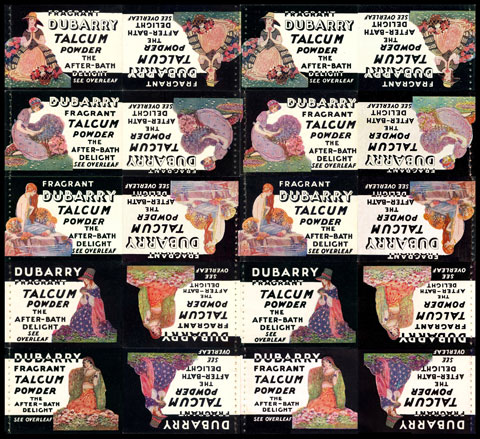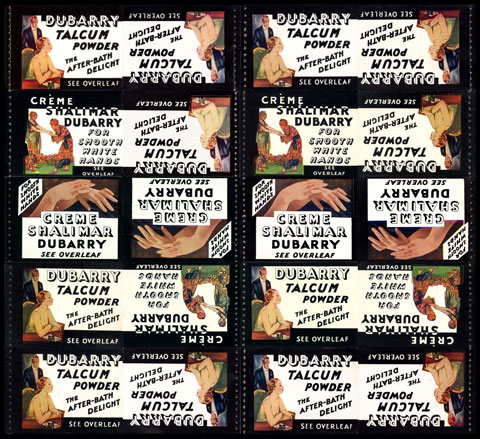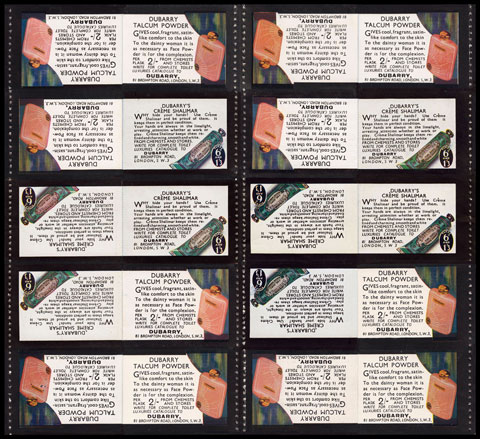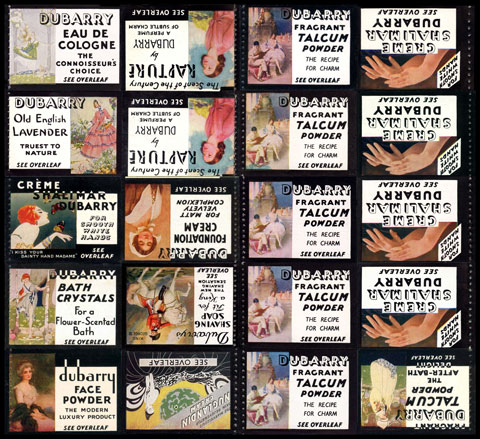
Full colour adverts for Dubarry cosmetics were included in 21 editions of 2s, 3s, and 5s booklets from February 1936 until October 1939.
The adverts were designed and printed by The Dubarry Perfumery Co. of Hove, in colour on both sides of glazed card. The front showed a coloured picture with a black border and a few words in bold lettering, while the back showed the article advertised with product details in smaller print. There were 19 different designs.
Adverts were printed by Dubarry in sheets of 20, four across and five down, and delivered to Harrison & Sons for inclusion in booklets. However, booklets were produced in blocks of 40, four across and ten down, so Harrison had to insert advert sheets in pairs. The total collation of covers, stamps and interleaves is termed “the mass”, which was stitched and separated into 40 booklets.
Several plates were used to print the adverts, referred to in British Stamp Booklets as Plates 1&2, Plates 3&4, and Plates 5&6. The origin of this numbering scheme is an unpublished manuscript by Mayer and Stanton which states “[adverts were] printed in two similar plates coupled together vertically”. A simpler numbering scheme of Plate 1, Plate 2, and Plate 3 is used here, each Plate being a set of printing plates for both front and back of the adverts.
| Ad | Plate | Design | Product |
|---|---|---|---|
| 1 | 1 | Rose girl | Talcum Powder |
| 2 | 1 | Girl by pool | Talcum Powder |
| 3 | 1 | Lavender girl | Talcum Powder |
| 4 | 1 | Lotus girl | Talcum Powder |
| 5 | 1 | Violet girl | Talcum Powder |
| 6 | 2/3* | Pair of hands | Crème Shalimar |
| 7 | 2 | Man and woman at opera | Talcum Powder |
| 8 | 2 | Oriental couple | Crème Shalimar |
| 9 | 3 | Carnival couple with mandolin | Talcum Powder |
| 10 | 3 | Fresh air girl in pink | Rapture |
| 11 | 3 | King George III | Shaving Soap |
| 12 | 3 | Girl with butterflies | Crème Shalimar |
| 13 | 3 | Girl between trees and pool | Bath Crystals |
| 14 | 3 | Girl in pink in garden | Old English Lavender |
| 15 | 3 | Quaker girl | Foundation Cream |
| 16 | 3 | Girl and Cupid in meadow | Eau de Cologne |
| 17 | 3 | Girl in white in garden | Talcum Powder |
| 18 | 3 | Gainsborough girl | Face Powder |
| 19 | 3 | Girl on sofa | Nuglandin Cream |
* there are two types of advert 6 easily distinguished from the back.
DUBARRY’S CRÈME SHALIMAR in two lines is Plate 2, in one line is Plate 3.
Number and Size of Plates
The first mention of Dubarry in the Post Office archives is in a letter of 27 March 1935 stating that Sells (Sell’s Advertising Agency Ltd, the Post Office advertising contractor) had received a proposal from Dubarry to include a “stiff paper coloured inset” in 20 booklet editions (21 editions were eventually produced) for which they were prepared to pay £100 per edition.
By August 1935 it became apparent that Dubarry could only produce sheets half of the size required (20 adverts instead of 40). The reason for this is unclear but it is likely that it was due to a limitation of Dubarry’s in-house printing department. In a letter of 23 August 1935 Harrison confirmed they had experimented with insertion of two half sheets (two 20 advert sheets) and required these to be approximately 11″ x 10¼” with the lay edges left on, enabling them to trim to size very near the time of insertion. The lay edge was a ¼” wide margin all around the sheet.
The first sheet of 20 adverts (Plate 1) was included in the 2s and 3s photogravure booklets of February 1936. A second sheet of 20 adverts was produced by Dubarry soon afterwards (Plate 2) and was included in photogravure booklets from May 1936. Plate 2 was also included in King Edward VIII and King George VI booklets.
In October 1936, Dubarry produced a larger sheet of 40 adverts. This received an acidic response from Harrison in a letter of 4 November 1936: “It will be readily seen the coloured inset has a wide centre of 1-3/32″, which compels the large sheet (equivalent to issue size stamp sheet) to be cut into half for binding purposes.”
Dubarry’s full size sheet had a gap across the middle, 20 adverts on top, an inch gap, then 20 adverts on the bottom. Harrison forwarded Dubarry’s sheet with their letter to the Post Office, and included a sheet of 2s booklet covers for comparison.
A meeting was held at Mount Pleasant on 13 November 1936 between the Post Office, Sells, and Dubarry. Booklet construction was explained to Dubarry, and the sheets sent to the Post Office by Harrison were returned to Dubarry. This is unfortunate, as no uncut Dubarry sheets remain in the Post Office archives, and in response to a letter from R. G. Woodall in 1948, it seems Dubarry did not keep any sheets either.
The meeting continued with Dubarry asking if the insertion rate could be reduced from £100 per issue to £70 per issue when sheets of the required size were supplied, and asking about a further reduction based on volume: “[Dubarry] intended to keep their plant fully employed in printing coloured advertisement interleaves for 10,000,000 books per year, would consider increasing the quantity to cover an interleaf in all books, i.e. 30,000,000 per year.”
Dubarry also asked about a perfumed blotting paper advert and was informed that the answer would probably be “in the negative”.
There is no record of how many sheets of 40 were printed, nor of which adverts were used, but as the majority of Plate 3 adverts have been identified in two settings, with one setting more common than the other, it is probable that the sheet had two slightly different impressions of Plate 3, and also probable that the initial supply of sheets of 40 were guillotined and used as two sheets of 20, with further printings of Plate 3 in sheets of 20 only.
Plate 3 was included in King Edward VIII booklets from November 1936 (matching the date the full size sheet was produced), and also in King George VI booklets.
No further correspondence is in the archive until August 1939. Dubarry requested the final two editions in King George VI booklets with the adverts to be delivered in sheets of 20 as before. The sheet of 40 was never corrected.
Printing Process
Two different processes were used to print the adverts, one process for the coloured images, many of which were taken from Dubarry’s existing advertising and packaging materials, and a second process for the black text and borders, which were created for the booklet insets.
The coloured images were printed using three colour offset lithography with Blue, Red and Yellow inks. This was similar to the modern CMYK colour process but without the use of a Key (black). The full continuous range of colours was produced by printing the three primary process colours in Halftone, small dots of each colour printed in a pattern that the eye perceives as a solid colour. Black is produced by printing all three colours together, although the black is not as deep as that produced by CMYK.
Offset lithography uses a photographic process to transfer images from the original material to printing plates. Hence very few settings can be identified by the coloured image as similar adverts are photographic copies. Only adverts with damage to the plates, such as the scratch on the Carnival Couple, can be identified this way.
The black text and borders were printed using letterpress (in philately, letterpress printing is sometimes called typography). The fine details of text is more easily reproduced using letterpress as printing text in three colours requires accurate registration and, as can be seen in many of the adverts, colours were often poorly registered.
The artwork for the letterpress plates appears to have been done by hand, resulting in many small differences between similar adverts. These differences identify the settings.
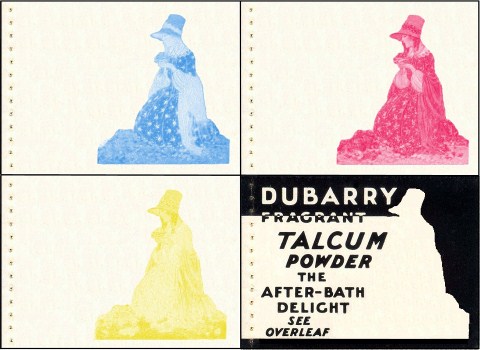
Violet Girl separated into four colours: blue, red, yellow and black.
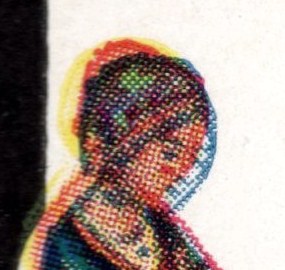
Oriental Couple detail showing poorly registered colours.
Three colours can be seen around the head.
Layout Techniques
The techniques used to identify the position of adverts within each Dubarry sheet were as follows:
Perforation Types on Panes of Stamps
With the exception of booklets perforated on the reserve perforator (which are rare, some examples are believed unique) booklets with imperforate (I) or one extension hole (E) selvedge are from outer columns of the sheet. Booklets with perforated (P) selvedge are from inner columns of the sheet.
Details of sheet perforations are given under Sheets & Perforations.
| I/E | P | P | I/E |
| I/E | P | P | I/E |
| I/E | P | P | I/E |
| I/E | P | P | I/E |
| I/E | P | P | I/E |
Guillotine Cuts
Dubarry sheets were trimmed to size by guillotine before assembly into the mass. After stitching, individual booklets were separated by rotary cutter. On most booklets the different cuts are easily distinguished. The guillotine leaves a very crisp cut, smooth to the touch when running a finger along the edge. The rotary cutter leaves a dashed pattern, and rough to the touch. This is most useful on the top and bottom edges of the advert and can be used to find adverts from the top and bottom rows of the sheet.
Two Dubarry sheets were needed per mass, the sheets butting together between the middle booklet rows. When separated by rotary cutter, one or both of these butted edges would be roughened. Thus, while a guillotined edge indicates a top or bottom row, a rotary cut is not always a middle row.
Using these first two layout techniques, and enough examples, it is possible to identify the four adverts from the corners of the sheet, the four from the top & bottom edges, the six from the left & right edges, and the six from the middle positions.
Duplicate Halves
Plates 1 and 2 were laid out as two halves, with the 10 designs in the left two vertical columns repeated in the right two vertical columns. Each advert in column 1 is repeated in column 3 and each advert in column 2 is repeated in column 4. The duplication process was not exact and there are small differences between all adverts. Once an advert is assigned to a specific position, its duplicate can easily be identified and placed in the corresponding position in the other half of the sheet.
White Borders
Plate 3, with more designs, was not laid out in duplicate halves, but there is a white border on the back of some adverts.
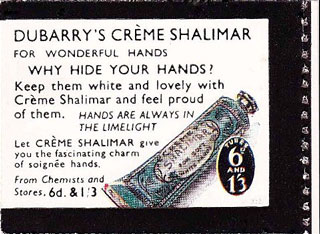
A white border is to the right of the stitch holes on the back of all settings of advert 6 Type II, and on advert 17. It seems the plate used to print the back was either too narrow or was offset to one side. Five adverts can be put together to form a vertical column with a continuous white border on one side of the sheet.
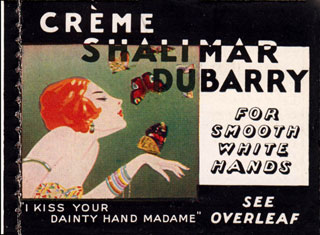
A white border is occasionally seen on the front of adverts 12, 13, and 14, to the left of the stitch holes. This border is narrower and less consistent than the one on the back but suggests that these adverts are from the opposite edge of the sheet.
Stamp and Interleaf Sheet Markings
Some markings on the stamp and interleaf sheets occur at known locations, but as two Dubarry sheets were needed per mass, and each could be inserted either way up, each sheet marking gives multiple possible positions. These positions on the Dubarry sheet are specified as Rx/y where x is the row number 1 to 5, and y is the column number 1 to 4. The sheet markings for each position are summarized in a table below, the abbreviations for which are described and the positions analysed as follows, with positions listed from left to right across the sheet:
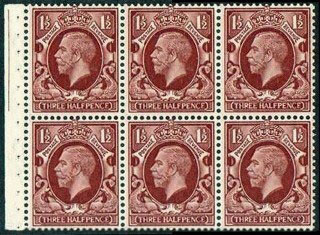
Line Top/Btm: a vertical cutting guideline printed at the four corners of stamp sheets. A line next to the top row of stamps corresponds to Dubarry position R1/1 or R5/4, and next to the bottom row corresponds to R5/1 or R1/4.
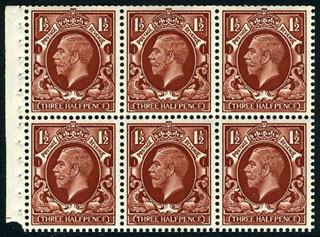
Punch Top/Btm: part of a perforation registration hole between stamp rows 14 & 15. Panes are found with part of a punch hole and part of a guideline from each side of the double size stamp sheet with extension perforation (E) in those left and right selvedges. A hole in the top corner of the pane corresponds to Dubarry position R3/1, R4/1, R2/4 or R3/4, and in the bottom corner corresponds to R2/1, R3/1, R3/4 or R4/4.
No booklets contain a mixture of panes with holes in the top and bottom corners, but some Dubarry adverts are found in booklets with top holes, and in different booklets with bottom holes. These adverts come from the overlapping positions of R3/1 and R3/4.
A few sheets were punched between stamp rows 7 & 8 in preparation for perforation by a continuous web machine. The holes appear in the centre of the selvedge, but none have been seen in booklets with Dubarry adverts.
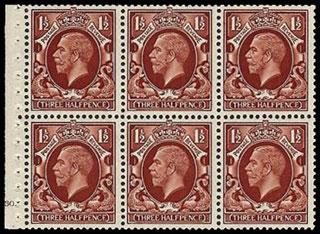
Cyl No: the cylinder number on stamp row 18 which corresponds to Dubarry position R4/1 or R2/4.
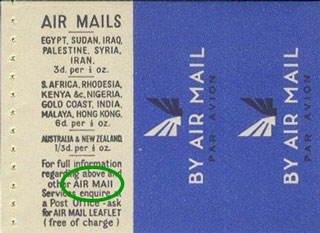
Air Maii: a typographical error with MAII instead of MAIL introduced when the inscription was changed in June 1936. Booklets with Plate 1 adverts were issued before this date so do not contain this air mail pane. The error corresponds to Dubarry position R2/1 or R4/4.
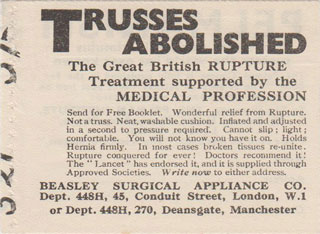
Ed+Val Upr/Inv: the manuscript edition number and value printed on interleaf row 9. Upright (value at the top, as shown) corresponds to Dubarry position R2/2 or R4/3, inverted (value at the bottom) corresponds to R4/2 orR2/3. A small number of interleaves, such as those in 5s booklet edition 14, do not follow this format.
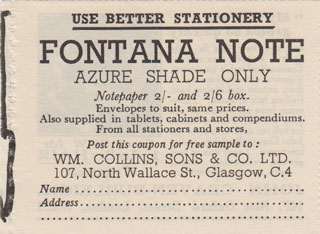
Int No Upr/Inv: the manuscript interleaf number printed on interleaf row 10.
Upright (as shown) corresponds to Dubarry position R1/2 or R5/3,
inverted corresponds to R5/2 or R1/3.
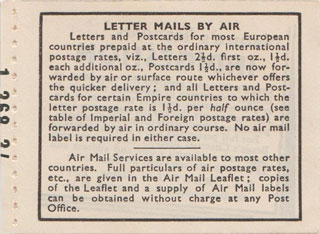
A typeset format was used in 1939, printed in the “Int No” position.
Upright (value at the top) corresponds to Dubarry position R1/2 or R5/3,
inverted (value at the bottom, as shown) corresponds to R5/2 or R1/3.
Stamp and interleaf sheet markings are summarized in this table:
| R1/1 Line Top |
R1/2 Int No Upr |
R1/3 Int No Inv |
R1/4 Line Btm |
| R2/1 Air Maii Punch Btm |
R2/2 Ed+Val Upr |
R2/3 Ed+Val Inv |
R2/4 Cyl No Punch Top |
| R3/1 Punch Top Punch Btm |
R3/2 | R3/3 | R3/4 Punch Btm Punch Top |
| R4/1 Punch Top Cyl No |
R4/2 Ed+Val Inv |
R4/3 Ed+Val Upr |
R4/4 Punch Btm Air Maii |
| R5/1 Line Btm |
R5/2 Int No Inv |
R5/3 Int No Upr |
R5/4 Line Top |
Miscut Adverts
Occasionally Dubarry sheets were poorly aligned in the booklet mass, resulting in adverts that show part of an adjacent design. For Plate 1 most miscuts are on the middle vertical cut, resulting in part of the adjacent horizontal design showing inverted to the left of the stitch line. This is visible on loose advert panes but hidden beneath the stitching in complete booklets. For Plate 2 onwards, a wider black gutter was printed to allow for the stitched area, so most miscuts are between vertical pairs of adverts.
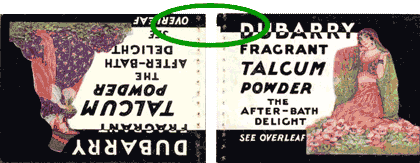
This horizontal pair shows advert 4.2.1 on the right with a step in the black border top left. This matches two possible adverts 5.1.1 and 5.1.2. Advert 4.2.1 has a guillotine cut along the bottom edge, both settings of 5.1 have guillotine cuts along the top edge. The perforation types of the booklets in which these adverts are found show 4.2.1 comes from a (P) or inner column position, as does 5.1.1, but 5.1.2 comes from an (I/E) or outer column position. Therefore only 5.1.1 matches:
| – – – | 5.1.1 | 4.2.1 | – – – |
This miscut pair can be built on as both are from inner columns, and each has a matching advert from the corresponding duplicate half of the sheet. In this case 4.2.2 and 5.1.2 which are from booklets with (I/E) perforations, giving a precise bottom row of the sheet:
| 4.2.2 | 5.1.1 | 4.2.1 | 5.1.2 |
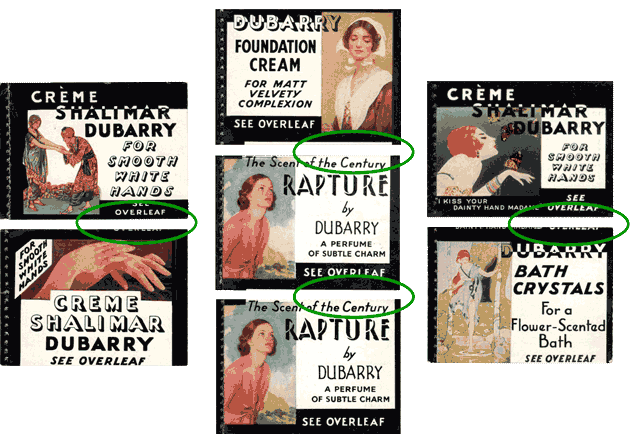
The left vertical pair above shows advert 6.1.1 with part of OVERLEAF along the top edge. This matches two possible adverts 8.1.1 and 8.1.2. The perforation types of the booklets in which these adverts are found show 6.1.1 comes from a (P) or inner column position, as does 8.1.1, but 8.1.2 comes from an (I/E) or outer column position. Therefore only 8.1.1 matches.
The middle vertical strip of three shows advert 15 with part of the white area from advert 10 along the bottom edge, and also advert 10.1 with a similar white area along the bottom edge. These are assembled as 15 above 10.1 above 10.2. All three adverts come from (P) or inner column positions, and 10.2 has a guillotined bottom edge.
The right vertical pair shows advert 13 with part of DAINTY HAND MADAME OVERLEAF along the top edge. This matches advert 12. Both adverts are from outer column positions.
Group 1
Group 1 consists of the 20 adverts from Plate 1.
This plate was the first produced by Dubarry and was included in only four editions of photogravure booklets. It has five similar designs, each repeated four times with small variations. The top three rows have one design per row, the bottom two rows have two designs alternating across the rows.
The plate was laid out as two halves, with the 10 designs in the left two vertical columns repeated in the right two vertical columns. The double vertical line in the table below separates the two halves.
| 1.2.2 | 1.1.1 | 1.2.1 | 1.1.2 | |
| 3.1.2 | 3.2.2 | 3.1.1 | 3.2.1 | |
| 2.1.1 | 2.2.1 | 2.1.2 | 2.2.2 | |
| 5.2.2 | 4.1.1 | 5.2.1 | 4.1.2 | |
| 4.2.2 | 5.1.1 | 4.2.1 | 5.1.2 |
From the layout data seen, row 3 (advert 2) can be assembled in two ways. The layout shown here was chosen based on the image content following row 2 (advert 3). The alternative is:
| 2.2.2 | 2.1.2 | 2.2.1 | 2.1.1 |
The Group 1 designs used the full width of the insert, resulting in some of the design being hidden under the booklet stitching. This also resulted in many miscut adverts in the middle two columns as the designs were back-to-back. The reconstruction below has five miscut adverts, one on each row.
Plate 1 Layout — click the image to enlarge.
Group 2
Group 2 consists of the 20 adverts from Plate 2.
This plate is straight forward to reconstruct as there was an uncut sheet of 20 in Stan Hills’ collection. It was described in an article in Stamp Weekly in June 1970 as “an actual plate believed to be the only one in existence”. The plate is reproduced in black and white in British Stamp Booklets. The detail is not fine enough to distinguish settings, but a transparency of the image exists which does provide sufficient detail.
The plate was laid out as two halves, with the 10 designs in the left two vertical columns repeated in the right two vertical columns. The double vertical line in the table below separates the two halves. The uncut sheet has since been cut along this vertical line into two half sheets, both of which are in private hands.
| 7.2.8 | 7.2.3 | 7.2.7 | 7.2.4 | |
| 8.1.2 | 7.1.2 | 8.1.1 | 7.1.1 | |
| 6.1.3 | 6.1.4 | 6.1.1 | 6.1.2 | |
| 7.3.1 | 8.2.1 | 7.3.2 | 8.2.2 | |
| 7.2.5 | 7.2.1 | 7.2.6 | 7.2.2 |
The reconstruction below shows that the layout of this plate is more symmetrical than Plate 1 and could be inserted into the booklet mass either way up. The image shown in the Stamp Weekly article and that shown in British Stamp Booklets are one upright and one inverted, although it is not known which way up was considered upright. The black borders between adverts are larger, and wide enough that the stitched area did not obscure any of the design.
Plate 2 Layout — click the image to enlarge.
The layout of the back of Plate 2 was also symmetrical, with the Crème Shalimar adverts (Pair of hands & Oriental couple) placed such that the back could be printed either way up and still match the front.
The back shows small differences between adverts, often with the punctuation, allowing individual adverts to be identified. Each front advert is usually found with the same back, but occasionally with the back from the diagonally opposing position, showing that the printing direction was usually in one direction, but occasionally in the inverted direction.
Plate 2 Back — click the image to enlarge.
Group 3
Group 3 consists of the 20 adverts from Plate 3.
This plate is the most difficult to reconstruct as there were more advert designs, and the designs were not laid out in a regular pattern as in the first two plates. The reconstruction is further complicated by 2s booklet edition 372 which has slightly different settings. Care must be taken to distinguish between adverts which are repeated within the single 20 advert plate (such as adverts 10.1 and 10.2 which are from different locations, R2/2 and R1/2) versus adverts which are from edition 372 (such as adverts 11.1 and 11.2 which are from the same location, R4/2, but from different editions).
The white border on the back of adverts 6.2 and 17 provides a good starting point for the reconstruction. Guillotined edges identify adverts 6.2.1 and 17 as corner positions, and sheet markings identify the other three advert 6.2 settings in the middle positions, giving a precise side column layout. The opposite side can then be populated with adverts with the same attributes placed in diagonally opposing positions. Advert 16, for example, with a guillotined top edge and (I/E) perforations, diagonally opposes advert 17 which has the same edges and perforations. Advert 14 with the AIR MAII error, diagonally opposes advert 6.2.3 with the same error, and so on to complete both outer columns.
| 16 | 6.2.1 | ||
| 14 | 6.2.5 | ||
| 12 | 6.2.7 | ||
| 13 | 6.2.3 | ||
| 18 | 17 |
The miscut vertical strip of three adverts (15, 10.1, and 10.2 with a guillotined bottom edge) gives part of an inner column. The adjacent inner column can then be populated with adverts with the same attributes placed in diagonally opposing positions. Advert 9.2, for example, with a guillotined bottom edge and (P) perforations, diagonally opposes advert 10.2 which has the same edges and perforations. A miscut advert 10.2 has part of advert 16 along the right edge, which connects the inner columns to the outer ones.
| 10.2 | |||
| 10.1 | |||
| 15 | 9.1 | ||
| 9.4 | |||
| 9.2 |
The remaining four positions contain adverts 9.3 and 11 (in the “Ed+Val Inv” position, either way around), and adverts 9.5 and 19 (guillotined top edge position, either way around). A miscut advert 9.5 has part of advert 9.3 along the bottom edge, which places them in the same column, and therefore 11 and 19 are in diagonally opposing positions in the adjacent column.
| 9.5 | |||
| 9.3 | |||
| 11 | |||
| 19 |
This last partial layout can be merged as shown, or it can be inverted. The layout below was chosen based on the image content, with all of the advert 9 settings placed in the same vertical column. This seems the most likely solution, but another miscut advert is needed to confirm this choice.
| 16 | 10.2 | 9.5 | 6.2.1 |
| 14 | 10.1 | 9.3 | 6.2.5 |
| 12 | 15 | 9.1 | 6.2.7 |
| 13 | 11 | 9.4 | 6.2.3 |
| 18 | 19 | 9.2 | 17 |
Plate 3 Layout — click the image to enlarge.
Group 3 Full Size Plate
The timing of the full size sheet matches the introduction of Plate 3. Most Group 3 adverts have been identified in two settings, with one setting more common than the other, so it is possible that the full size sheet had two slightly different impressions of Plate 3. Alternatively, the two impressions could be indistinguishable and the other settings produced by a change in the printing process.
The coloured images on each pair of settings are identical, even the scratch in 9.1 occurs in both 9.1.1 and 9.1.2, suggesting that they were printed by two complete rotations of the cylinders with the “wide centre” caused by the Cylinder Gap. However, the black images show small differences which are seen in most, but not all settings.
The table below shows the layout with two different impressions of Plate 3, with settings in the upper half more common than those in the lower half.
| 16.1 | 10.2.1 | 9.5.1 | 6.2.1 |
| 14.1 | 10.1.1 | 9.3.1 | 6.2.5 |
| 12.1 | 15.1 | 9.1.1 | 6.2.7 |
| 13.1 | 11.1 | 9.4.1 | 6.2.3 |
| 18.1 | 19.1 | 9.2.1 | 17.1 |
| 16.2 | 10.2.2 | 9.5.2 | 6.2.2 |
| 14.2 | 10.1.2 | 9.3.2 | 6.2.6 |
| 12.2 | 15.2 | 9.1.2 | 6.2.8 |
| 13.2 | 11.2 | 9.4.2 | 6.2.4 |
| 18.2 | 19.2 | 9.2.2 | 17.2 |
The reconstruction below shows the full size sheet alongside a sheet of 2s booklet covers, similar to the sheets sent to the Post Office by Harrison in November 1936 to illustrate the “wide centre” which had to be cut out for binding.
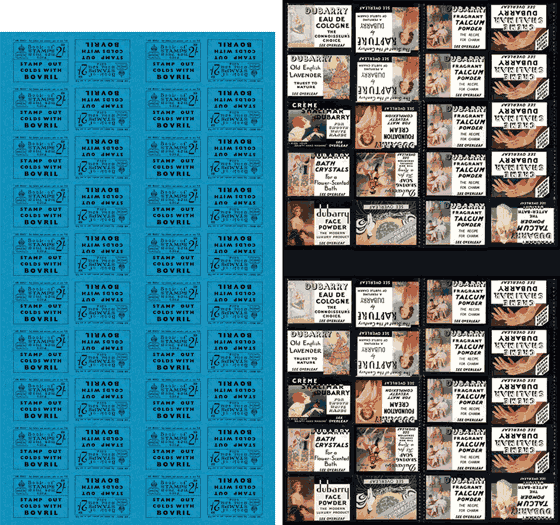
Full Size Plate Layout
Next: Dubarry Backs
